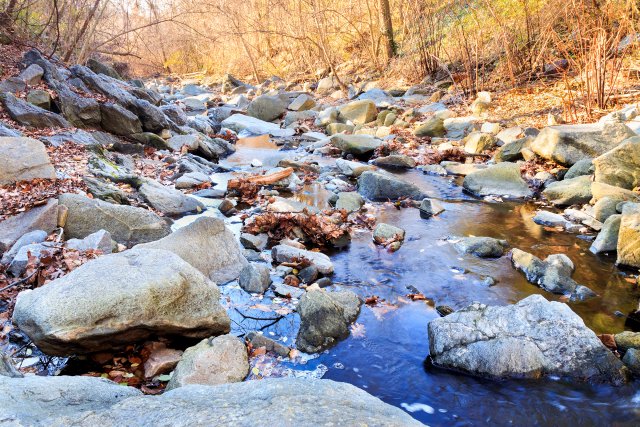EPA Researchers Develop Tool to Improve Water Quality
Published August 23, 2018

That’s why EPA developed the Watershed Management Optimization Tool (WMOST), a tool that helps water resource managers and planners identify cost-effective, environmental and economically sustainable decisions to improve water quality and quantity.
WMOST supports integrated water management by allowing users to consider stormwater, drinking water, waste water, and land conservation management practices to find solutions. The newly-released WMOST version 3 includes a water quality module that allows users to identify the most cost-effective management practices for reducing pollution. It also has a module that helps users reduce overflows from combined sewer systems, a common problem for these types of systems. EPA conducted two case studies to test and refine WMOST version 3.
The Taunton River Watershed
In the first case study, EPA researchers used WMOST to analyze two subwatersheds in the upper Taunton River Watershed, the second largest watershed in Massachusetts. The watershed faces challenges such as flooding, storm surges, and sea level rise.
Researchers wanted to identify strategies to reduce phosphorous levels in lakes and flowing waters in the watershed, as well as nitrogen levels in Mt. Hope Bay, a portion of the Narragansett Bay estuary located at the mouth of the Taunton River. They also wanted to maintain a minimum low flow in streams throughout the watershed to create a stable water supply and support local fish populations.
To achieve these goals, EPA researchers considered “green” or nature-based watershed management options such as land conservation, green infrastructure, and riparian buffer restoration—planting trees along a stream. The team also considered “grey” or traditional infrastructure options like repairing water infrastructure leaks, upgrades to the wastewater treatment system, water conservation, and aquifer storage and recharge options.
After using WMOST to analyze the options, researchers found that infiltration basins – a green infrastructure option for stormwater management – were the most cost-effective option to meet the watershed’s water quality goals. The researchers are currently working with partners to identify the best options in the case of future growth and climate related effects. The findings from this stage of the research will be shared with the communities before any of the options are implemented.
Resilient Taunton Watershed Network (RTOWN), a local organization which includes regional organizations and state and federal representatives, is using the results of the study and WMOST version 3 to inform their approach to watershed management. R-Town is applying WMOST version 3 to future growth and climate scenarios to identify the most cost-effective management actions. Members of the organization will share initial results from future growth scenarios with communities before considering potential management options. In addition, one consortium member is taking part in an ongoing series of WMOST v3 training webinars designed to support communities, states, tribes, and watershed organizations wishing to apply WMOST to their own case studies.
Cabin John Creek
EPA conducted a second case study that focused on the highly-urbanized Cabin John Creek in Montgomery County, Maryland (MD), a tributary to the Potomac River which flows into Chesapeake Bay. EPA researchers partnered with the Maryland Department of Environment, Montgomery County, MD State Highway Administration, and the City of Rockville to determine the most cost-effective management strategies for reducing local sediment in Cabin John Creek. Researchers also worked to determine how to reduce the loads of nitrogen, phosphorus, and suspended sediment—to the Chesapeake Bay.
To reduce sediment while minimizing cost, researchers considered management strategies such as forested riparian buffers and best management practices including street sweeping, urban nutrient management, stream restoration, and tree canopy cover over turfgrass. Researchers found that riparian buffer restoration was the most cost-effective option for reducing nitrogen or phosphorous alone. However, the optimal management options to meet the more stringent sediment loading goals included a combination of infiltration basins, sand filters, and dry pond to wet pond conversions, all of which increase infiltration and reduce runoff.
Researchers also used WMOST to examine management actions required to meet targets for peak flow following storms. Researchers estimated peak flow targets based on relationships between flow and amount of suspended sediment in the nearby Anacostia Creek. This relationship reflects the effect of instream contributions of sediment from stream bank erosion as well as runoff inputs from the surrounding watershed. An even greater application of best management practices was required to meet peak flow targets, including bioretention basins and riparian buffer restoration in addition to the previous suite of management practices.
Both EPA and the state government of Maryland benefited from the study. The state of Maryland found the case study to be very informative and hopes to include the results in their implementation guidance to help communities meet water quality goals. Based on input from the state of Maryland, EPA added additional management practices in WMOST (street sweeping, canopy over turf, urban nutrient management, stream restoration, outfall enhancement) beyond those originally planned, ensuring greater applicability for stakeholders. EPA will also be using the results from each case study in write-ups that will assist in training other users as they apply WMOST to their own case studies.
Each of these case studies demonstrate that EPA’s WMOST is a valuable resource that can help decision-makers and planners choose a water management strategy most beneficial to their communities. The newest version of WMOST, refined in these case studies, provides even more information to guide communities and helps EPA fulfill its mission to protect human health and the environment.
